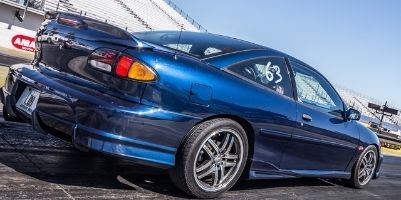In my general experience online on sites like these and previously on v6camaro.com I've come across a huge trend that really is nothing new but I believe is GROSSLY misunderstood and not particularly well used. The optional temperature thermostat.
"Back in the day" The solution to low grade fuels in higher performance engines (That ran pig rich and comparatively VERY inefficiently) was obviously not to reduce power by pulling timing (You could not do that "on the fly', no knock sensors) You could not obviously reduce compression easily, and you very well had to spend a good half hour if you wanted to re-jet your carburetor to get more fuel in the cylinders to cool them down and prevent knock. Certainly an easy task now a days with just a few clicks of the mouse.
So? Well by golly put a colder T-stat in it! Lower running temps must = better power because we can advance timing more and get more power out of the fuel we are dumping into the cylinders.
Then we had knock sensors, now spark timing was controlled to a certain extent and we no longer had to worry about being able to throw timing at it. Therfore no need to worry about pings, knocks, or detonation.
All fine and good until the 70's hit and we began to be concerned with emissions. A little Agency called the EPA decided they wanted to restrict what came out of our tailpipes.
One of the biggest advances in Air/Fuel delivery was when it was noted that cold start emissions are the highest. Still holding true today it takes over 25-40% more fuel to start a cold engine then to start a warm engine. So whats the catch? Automakers had to find a way to get the engine up to temperature as quickly as possible. This led to things such as thermostatic switches that opened doors in Air filter housings so air was drawn from around the exhaust manifolds (Got hot first) and pulled into the air filter considerably warmer then ambient. This helped atomize the fuel better and we STILL see if today in throttle bodies with coolant jackets in them and intake manifolds with coolant passages in them.
The bottom lines are this...Engines make power by converting chemically stored energy in gasoline into heat and heat into motion via the pistons and crankshaft. So why on gods earth would you put a thermostat thats 20 degrees cooler than the manufacturer intended into any engine big or small that you look to make serious horsepower with? The point of ceramic coatings on piston tops and cylinder heads is to keep heat in so it can more effectively be converted into power for a longer amount of time. So why would you want that engine at anything less than full operating temperature?
This also calls to mind something that in carburation is important. What about the vaporization of the fuel? Fuel vapor burns, Liquid gasoline DOES NOT. So the faster we can get the fuel Vaporized (Hotter Temperature we can get it in its short trip to the valve) The better. Again, why would you ever want any less heat in the engine than whats already there? Fuel injection helps alot with this, but fuel Vaporization is still a BIG issue especially with higher revving engines today, theres simply less time to get the same work done.
In the OEM world, we have seen steadily an increase in thermostat temps, I dont see why we won't see engines happily running at 205-220 no problem for their lifetime and get better fuel economy and better power out of it.
The big question is...do you NEED a cooler thermostat? I dont think so, I dont run one, I wont run one, ever, Instead with the capabilities we have in tuning I think we should at least aim to keep coolant temps in the stock range, as that is what the engines are happiest running at as per OE. Keep in mind EVERY clearance in an engine takes into account thermal expansion...IF it were my engine and I was not willing to rebuild it at the very least every season, I would go with the specified clearances and of course, get it up to operating temp as quickly as possible to minimize the amount of time that elapses when parts are damaged and suffer the most wear due to being cold. There is alot of misinformation about alot of things and I think running a cooler thermostat is construed as a good thing when in reality its about as useless as a "tornado air management system" Its right up there on my list of things that demonstrate an ignorance to what it takes to make workable and useable power on todays engines along with "well Im going to put a header on my car cause it flows better" coming from a person who's done no head work...
So if it were up to me, I would recommend a stock thermostat, a premium one, but otherwise OE temperature and configuration. OEM cooling systems are MORE than adequate to support horsepower levels in excess of 30-50%. Beyond that, the first thing is a radiator.
So folks, moral of the story, dont touch your thermostat!

Buildin' n' Boostin for 08' - Alex Richards
good read. I work at a parts store and i see people do this on a daily basis, no matter how hard i try to convince them to use a factory temp stat they just tell me i dont know any better and to give them the one they want.

Goddamnit I miss my edit button.

Most people drop from a 180 to a 160, not 195 to 180.
I agree a cooler stat is not needed. In a lot of cases won;t change the running temps. Heck running without a stat a lot of times won;t change running temps. I think OE's try running todayd cars hotter to get better emission's. So if into performance, and doing a full build, or at least doing custom tuning then a cooler stat could be considered.
I'm a firm believer in every little think helps.
 FU Tuning
FU Tuning
John Higgins wrote:Most people drop from a 180 to a 160, not 195 to 180.
I agree a cooler stat is not needed. In a lot of cases won;t change the running temps. Heck running without a stat a lot of times won;t change running temps. I think OE's try running todayd cars hotter to get better emission's. So if into performance, and doing a full build, or at least doing custom tuning then a cooler stat could be considered.
I'm a firm believer in every little think helps.
This is true, but less emissions mean it runs more efficiently, and I think we all know what efficiency can do for a motors performance. (LS1, L61, LNF etc. need I say more?) Thats the connection I see.
LOL at poking fun at the 2.2...ITs almost as much as a part of the hobby as the hobby itself... Plus it can take it

I did not mean to state that as an elitist, The overall point was for the MOST gains a header will only flow as good as the head its attached to. A cooler thermostat is only as good (or bad) as the motor that it is installed in. The overall generalization of modifications in cars today has brought the little knowledge being a dangerous thing adage to light. I related this because most people dont understand why there even is cooler thermostats available and why they may be detrimental to a powerplants health.
Carry on :-)

Buildin' n' Boostin for 08' - Alex Richards
Quote:
The overall point was for the MOST gains a header will only flow as good as the head its attached to. A cooler thermostat is only as good (or bad) as the motor that it is installed in.
I agree with this comment totally. This goes for any mod you can do to any car, motor etc...
Quote:
but less emissions mean it runs more efficiently, and I think we all know what efficiency can do for a motors performance
I also agree, at least on efficiency and performance. This goes along with a topic in the tuning section. Which I feel our motors can be mae to run just as efficient, but cooler.
 FU Tuning
FU Tuning
I admit, a lot of people going to 160 degree thermos when stock is like 185 or 195 on some cars is too cold and will cause most cars to never warm up and the ECU keeps in closed loop mode and dumps in too much fuel and you end up with less power, horrible fuel economy. But, going from 195 to 180 or so, not that big a deal. On a car with overheating issues, like for instance a car with a big FMIC that blocks the radiator, this may help a little in keeping the car from getting too hot too quick since the stock cooling system was designed for a stock car.
I totally don't agree with the header analogy. You would then be assuming that every car's exhaust manifold/header is the best design possible in matching the head's capability and that no concessions were made to cost, packaging, or longevity. This is most certainly not true even on cars that claim to be "performance oriented."
GM allows a crank/cam variation relearn at 160* F so I would assume that 160* is where it is safe to beat on a GM engine. The relearn basically involves a free rev to at least 4000 RPM at WOT. Some engine do this very quick.

Tourian wrote:I admit, a lot of people going to 160 degree thermos when stock is like 185 or 195 on some cars is too cold and will cause most cars to never warm up and the ECU keeps in closed loop mode and dumps in too much fuel and you end up with less power, horrible fuel economy. But, going from 195 to 180 or so, not that big a deal. On a car with overheating issues, like for instance a car with a big FMIC that blocks the radiator, this may help a little in keeping the car from getting too hot too quick since the stock cooling system was designed for a stock car.
I totally don't agree with the header analogy. You would then be assuming that every car's exhaust manifold/header is the best design possible in matching the head's capability and that no concessions were made to cost, packaging, or longevity. This is most certainly not true even on cars that claim to be "performance oriented."
yea you are right about closed loop = very bad!!! Thats the last thing you want in any car, it has to be warmed up so it can go in to open loop and provide the right amount of fuel. More fuel isnt always better.... 10 -15 degrees may or may not make a difference, but you definitely dont want your car to be in closed loop!
Closed loop is where you want the car to when it warms up.

Tourian wrote:like for instance a car with a big FMIC that blocks the radiator, this may help a little in keeping the car from getting too hot too quick since the stock cooling system was designed for a stock car.
I missed this previously....a cooler thermostat will not solve overheating problems no matter how much of the radiator is blocked. Remember kids, thermostats set the MINIMUM operating temperature of an engine, not the maximum.

Buildin' n' Boostin for 08' - Alex Richards










